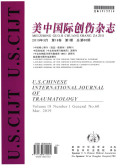- 钛学术文献服务平台 \
- 学术期刊 \
- 医药卫生期刊 \
- 外科学期刊 \
- 美中国际创伤杂志期刊 \
The Effect of Opsteoporotic Model Rats Induced by Retinoic Acid
The Effect of Opsteoporotic Model Rats Induced by Retinoic Acid
基本信息来源于合作网站,原文需代理用户跳转至来源网站获取
摘要:
Objective: To study the effect of retinoic acid on inducing osteoporosis in female rat. Methods: 48SD female rats were divided randomly into experiment group and control group. Retinoic acid was administered orally to experiment group with 80mg.kg-1d-1 for 15 days. Then the rats were sacrificed on the 0th, 30th, 60th days after last administration. The serum concentration of Ca, P, BGP, E2, AKP and TRAP were detected. Components of collagen and proteoglycan in the bones and BMD were also assayed .The femoral morphometric change and epiphyseal plate cartilage histological changes were observed. Results: After a 15-day period treatment with retinoic acid, charateristics of experiment group were compared with control, it is shown that the concentration of serum E2 and BGP declined, the activity of AKP and TRAP increased while BMP decreased, the bone mass of both spongy bone and cortical bone reduced, the number of spongy bone osteoclasts and their activity increased, number of epiphyseal plate chondrocyte reduced, cartilage hypertrophic zone displayed dyscalcification, and no difference of other markers was found in the two groups. On the 30th day after the last administration, the experiment group appeared a declined number of cancellous bone osteoclast and level of serum AKP yet they were still higher than control. Number of epiphyseal chondrocyte, serum BGP and tibial BMD, though higher than before, were still lower than control. Other markers were no difference. On the 60th day after treatment, although the femoral cancellous bone mass was still less and cancellous osteoblast was more than control, the cortical bone mass, cancellous osteoclast number and level of serum Ca and P were all remained no different between two groups.Conclusion: Retinoic acid possessed a better short-term effect than long-term effect. Cancellous bone loss lasted much longer than cortical bone and more obviously; the bone matrix in this osteoporosis model was able to repair itself gradually after withdrawal of retinoic acid.

推荐文章
Influence of litter decomposition on iron and manganese in the sediments of wetlands for acid mine d
AMD
Sediments
Litter decomposition
Forms of Fe and Mn
Isotherm and kinetic studies on the adsorption of humic acid molecular size fractions onto clay mine
Kaolinite
Montmorillonite
Leonardite humic acid
Humic acid fractions
Kinetics
Equilibrium
Rock chemical weathering by sulfuric acid: pathway, method and prospect
Chemical weathering
Sulfuric acid
Global climate change
Sulfate isotope
内容分析
关键词云
关键词热度
相关文献总数
(/次)
(/年)
引文网络
引文网络
二级参考文献 (5)
共引文献 (26)
参考文献 (5)
节点文献
引证文献 (0)
同被引文献 (0)
二级引证文献 (0)
1979(1)
- 参考文献(0)
- 二级参考文献(1)
1988(1)
- 参考文献(0)
- 二级参考文献(1)
1989(2)
- 参考文献(1)
- 二级参考文献(1)
1993(2)
- 参考文献(0)
- 二级参考文献(2)
1996(1)
- 参考文献(1)
- 二级参考文献(0)
1997(1)
- 参考文献(1)
- 二级参考文献(0)
1999(1)
- 参考文献(1)
- 二级参考文献(0)
2000(1)
- 参考文献(1)
- 二级参考文献(0)
2005(0)
- 参考文献(0)
- 二级参考文献(0)
- 引证文献(0)
- 二级引证文献(0)
研究主题发展历程
节点文献
Osteoporosis
Rat
Retinoic acid
Bone
Cartilage
研究起点
研究来源
研究分支
研究去脉
引文网络交叉学科
相关学者/机构
期刊影响力
美中国际创伤杂志
主办单位:
美国中华医学会
出版周期:
季刊
ISSN:
1538-814X
CN:
开本:
出版地:
陕西西安市南稍门红会路3号西安市红十字会医院
邮发代号:
创刊时间:
语种:
chi
出版文献量(篇)
1584
总下载数(次)
2
期刊文献
相关文献
推荐文献

 免费查重
免费查重










